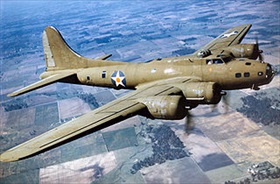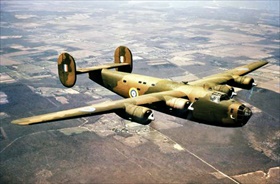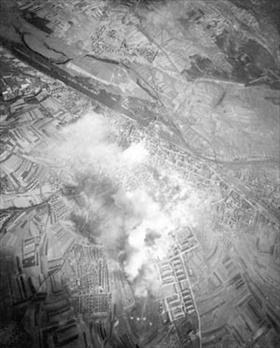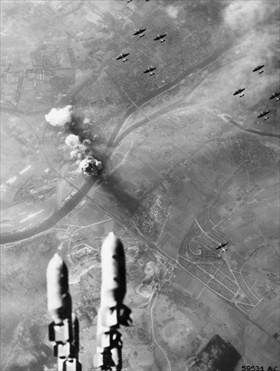BOEING B-17 HEAVY BOMBER MAKES MAIDEN FLIGHT
Seattle, Washington State • July 28, 1935
On this date in 1935 a prototype 4‑engine bomber took off from Seattle, Washington’s Boeing Field on its first flight. The plane, known simply as Model 299 among Boeing employees, bristled with machine-gun mounts in its nose, sides, top, and tail. Dubbed the “Flying Fortress,” allegedly by a Seattle news reporter, the name was quickly adopted and trademarked by Boeing. The U.S. Army Air Corps, whose request for a long-range, multi-engine bomber prompted Boeing to self-finance the prototype aircraft, designated the plane the B‑17. Military deliveries began in early 1937.
Prior to America’s entry into World War II, the B‑17 and its rival 4‑engine bomber, Consolidated’s B‑24 Liberator, were tested by Royal Air Force crews in combat against the German Luftwaffe in the spring of 1941. Neither bomber received high marks in the tests they were put through. Though British air squadrons eventually flew newer models of both American-built bombers, they preferred their own 4‑engine Handley Page Halifax, which made its operational debut in March 1941, and the 4‑engine Avro Lancaster, which entered combat 12 months later.
Stateside, B‑17s were inadvertently plunged into combat on December 7, 1941, during the Japanese aerial attack on Pearl Harbor, Hawaii. However, it was in the Philippines and the Dutch East Indies in the early months of the war that a mixed force of B‑17s and B‑24s made its intentional combat debut. In the face of rapid Japanese territorial advances southward the warbirds withdrew to Australia. There they formed the nucleus of the U.S. Army Air Force’s Fifth Air Force that would help defeat the Japanese in the Southwest Pacific. By the end of 1943, B‑17s in the Pacific Theater had been replaced by B‑24s.
Late in the summer of 1942 U.S. Eighth Air Force B‑17s launched daylight strategic bombing operations over Nazi-occupied Europe from air bases in England. Their initial targets were railroad marshaling yards in Rouen, 80 miles/129 kilometers inland from the French Normandy coast. Escorted by short-range RAF Spitfires, the first 2 Fortresses were lost on the Eighth’s tenth mission. A year later, in August and October 1943, the Eighth mounted aggressive unescorted air assaults designed to cripple military production deep inside Nazi Germany. Targeted were Bavaria’s Messerschmitt aircraft factory in Regensburg and Schweinfurt’s ball-bearing complex (see photo essay below). The carnage inflicted by Luftwaffe interceptor aircraft and lethal flax batteries resulted in the suspension of deep penetration strategic bombing missions for 5 months until heavy bomber inventory and highly trained 10‑man aircrews could be replenished and Allied long-range fighter support put in place.
By June 1944 the Allies’ fighter escort problem appeared solved with the introduction of North American’s long-range P‑51 Mustangs. Eighth Air Force B‑17 formations from England and Fifteenth Air Force B‑17 and B‑24 formations from Italy continued to smash Germany’s aircraft manufacturing facilities, followed by oil and transportation complexes. Allied ascendancy over the Luftwaffe’s fighter arm accelerated successes in the air and on the ground, presaging Germany’s unconditional surrender in May 1945. B‑17 production was suspended in favor of producing longer-range heavy bombers for the air campaign against the Japanese home islands. On August 6 and 9, 1945, 2 B‑29 Superfortresses, each carrying a city-killing atomic bomb, nudged Japan’s Emperor Hirohito (posthumously referred to as Emperor Shōwa) to surrender his country to the Allies 3½ weeks later, on September 2 in Tokyo Bay, ending a human tragedy that had made Boeing an airplane manufacturing legend.
The U.S. Eighth Air Force Schweinfurt-Regensburg Missions
 |  |
Left: By the time the U.S. entered World War II in December 1941 the Boeing B‑17 Flying Fortress was outdated based as it was on 1920s-early 1930s technology. Some 12,731 B‑17s were produced between 1936 and 1945. First flown in combat by the Royal Air Force over Europe, the British found the B‑17’s performance dismal and preferred flying the Consolidated B‑24 Liberator. B‑17s flew with the U.S., British, and Soviet air forces. The German Luftwaffe even flew a dozen captured ones. Flying Fortresses were armed with 13 .50 caliber (12.7 mm) M2 Browning machine guns in 8 positions. Depending on the distance of the mission, a B‑17 could carry between 4,000 and 8,000 lb/1,814 and 3,629 kg of bombs. More bombs were dropped by B‑17s than by any other U.S. aircraft in World War II. Of the 1.5 million metric tons of bombs dropped on Nazi Germany and its occupied territories by U.S. aircraft, 640,000 tons were dropped from B‑17s. During the course of the war more than 5,000 B‑17s were shot down by German fighter planes or flak batteries.
![]()
Right: Rare color photo of a preproduction B‑24 prototype wearing British rondelle. Six were sold to the UK directly as designated LB‑30A. Far more B‑24 Liberators were produced (18,500 units) and were used more extensively than Boeing B‑17 Flying Fortresses, both in strategic bombing campaigns, on long-range anti-submarine patrols, and as transports (C‑87s). In fact, only in the U.S. Eighth Air Force were B‑17s predominant in number. So many historians have focused on the war in Europe, devoting much paper and ink to the 4‑engine Boeing bomber, that the B‑17 is often thought to be the only American long-range bomber of the war until the much larger Boeing B‑29 Superfortress was put in service in May 1944. Ironically, the more modern B‑24 was designed to replace the B‑17, with vastly improved performance owing to a shoulder-mounted, low-drag, aerodynamically shaped wing (Davis wing) that afforded higher speeds, greater explosive payloads, and superior operational range. Conversely, the B‑17’s large wing made the plane easier to fly and at higher altitudes than the B‑24, but it produced considerable drag, limiting its speed and severely reducing its operational range. The B‑24 first flew on December 29, 1939, and entered service in 1941.
 |  |
Left: Smoke covers Schweinfurt’s manufacturing center as B‑17s from the 1st Bombardment Wing unload thousands of 500 lb/227 kg bombs on August 17, 1943. The Schweinfurt-Regensburg mission entailed 2 large forces of U.S. Eighth Air Force bombers (361 bombers in 16 bomb groups) attacking separate targets simultaneously, both in Bavaria, which placed them outside the range of escorting Allied fighters. Their orders: cripple German fighter aircraft production. The never-before “double-strike mission” in broad daylight into the heart of the Reich inflicted major damage on the Messerschmitt facility at Regensburg but minimal damage on Schweinfurt’s ball-bearing factories, for a catastrophic loss to the force: Over 40 percent of U.S. bombers were shot down, written off as beyond repair, abandoned, or ditched in the Mediterranean. Along with these 147 lost-to-service B‑17s, the Eighth lost 565 highly trained airmen killed, taken prisoner, interned in Switzerland, or counted as missing. Little more than 11 percent of the bomber force returned to base unscathed. On the flip side, the Germans lost 47 fighter aircraft and 16 experienced pilots to frenzied air combat, plus 5 more to accidents. A second raid on Schweinfurt on October 14 cost the Eighth 77 out of 351 B‑17s and B‑24s lost, 138 battle damaged (17 beyond repair), roughly 590 crewmembers killed and 65 taken prisoner, while producing moderate site damage. Sadly for Allied war planners, other European firms stepped in with replacement ball bearings while the Germans drew from their reserves.
![]()
Right: B-17 bomber stream over Regensburg, August 17, 1943. The major Messerschmitt aircraft factory at Regensburg produced over 300 Bf 109 fighters per month, or roughly a quarter of Germany’s fighter output in July 1943. The Regensburg daylight raid by the Eighth Air Force’s 4th Bombardment Wing lasted 22 minutes. Military intelligence later confirmed that the Messerschmitt complex suffered extensive damage, particularly to the company’s new Me 262 jet fighter production line, for a loss of 24 B‑17s.
The Air Force Story: Schweinfurt-Regensburg Raid, August 17, 1943. Skip first minute
![]()

 History buffs, there is good news! The Daily Chronicles of World War II is now available as an ebook for $4.99 on Amazon.com. Containing a year’s worth of dated entries from this website, the ebook brings the story of this tumultuous era to life in a compelling, authoritative, and succinct manner. Featuring inventive navigation aids, the ebook enables readers to instantly move forward or backward by month and date to different dated entries. Simple and elegant! Click
History buffs, there is good news! The Daily Chronicles of World War II is now available as an ebook for $4.99 on Amazon.com. Containing a year’s worth of dated entries from this website, the ebook brings the story of this tumultuous era to life in a compelling, authoritative, and succinct manner. Featuring inventive navigation aids, the ebook enables readers to instantly move forward or backward by month and date to different dated entries. Simple and elegant! Click 











